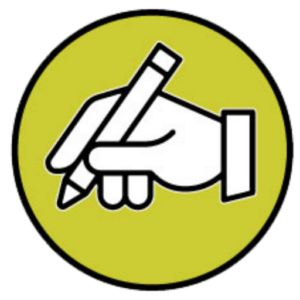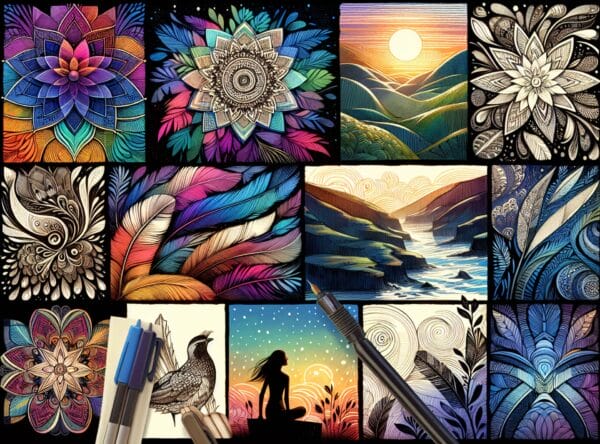Drawing with flexible brush pens is a fantastic way to create beautiful gradient effects because they blend colors seamlessly. Start with light pressure to lay down a pale hue, then add more pressure for a darker shade. You can also touch the tips of two brush pens to transfer some ink and create a stunning ombre effect as you draw.
Drawing with Brush Pens: Stunning Ink Washes and Backgrounds
Learn to use water-based brush pens to create beautiful flowers by employing an ink wash effect like a traditional watercolor painting. A light pencil line will help keep an area of ink wash from bleeding too far on the dampened paper.
After applying a little ink to the moistened watercolor paper, use a wet brush tip to spread and dilute the color over a larger area. This technique works excellently for atmospheric backgrounds or giving a soft touch to larger areas that don’t require precise lines.
Once the ink wash dries, lightly sketch the edges of petals and leaves using a 4H or 5H graphite pencil. Use these new pencil lines as guides for the next area of color. Then, let that dry before adding another layer of color and detail. When the flower is complete and the paper is dry, gently erase the pencil lines using a clean, kneaded eraser.
Atmospheric Brush Pen Techniques for Wet Paper
The brush pen technique on wet paper is well-suited for creating unique, spontaneous, and soft lines on artist-grade watercolor paper. This technique is perfect for artists of all skill levels, allowing for a blend of control and uncertainty. By applying pigment onto wet watercolor paper, you can achieve a range of subtle and expressive effects that defy the precision of traditional brushwork.
To master this technique, secure all the paper’s edges to a drawing board using low-tack masking tape. Then, dampen the paper with a wet brush or a spray bottle filled with clean water. This moist surface will allow the pigment to spread and blend as you brush it on, creating a fluid, organic appearance. Choose a brush pen with sensitive ink flow and good tip flexibility, as these will produce the most pleasing results.
Now, with your paper ready and brush pen poised, begin by making light strokes, allowing the tip of the brush pen to dance across the paper’s wet surface. Apply gentle, calculated pressure to control the ink flow, as too much pressure will result in unwanted lines or pooling.
As you work, be open to this technique’s unpredictable nature; the paper’s soft, watery texture will create unexpected opportunities for creative expression.
Use Brush Pens to Create Bold Monoline Drawings
One of the simplest yet striking uses for a brush pen is creating monoline drawings. Utilize the consistent width of the brush pen’s point to create a piece with a single-line weight. Doing this can highlight the subject’s form and provide a clean, modern look that stands out for its simplicity and boldness.
Precise Hand Lettering and Fluid Calligraphy
Here’s the condensed version: Brush pens are a favorite tool for calligraphers due to their versatility. They can produce a range of lines, from thin to thick, making them ideal for hand lettering. The subtle variation in line width and texture adds depth and dimension, giving the impression of hand-painted words. Calligraphers can experiment with different scripts and decorative flourishes, creating intricate designs that reflect their artistic style. The pen’s flow can be manipulated to create subtle variations in texture and shading, adding complexity to the design.
In addition to their artistic versatility, brush pens are known for their precision and control. The tip can be guided with precision, allowing artists to create sharp edges and fine details, making them an excellent choice for creating intricate work.
The even ink flow ensures that the color remains consistent throughout, resulting in a steady and reliable writing experience. Whether used for everyday correspondence, art projects, or as a professional tool, brush pens are essential to any artist’s toolkit.
Another significant advantage of brush pens is their ability to adapt to different paper types and textures. The ink flows smoothly and consistently across various surfaces, from smooth cardstock to rough watercolor paper, allowing artists to work with multiple materials and create unique textures and effects.
Simple Stippling and Surface Textures
Instead of using them for solid lines and washes, use your brush pens for stippling. Dotting with the tip of the brush pen can create varied textures depending on the size and spacing of the dots. This technique is perfect for adding dimension to drawings without heavy line work.
Experiment with varying brush strokes and pressure to create a range of textures, from delicate whispers to bold, expressive lines. To expand the possibilities, you can also combine different media, such as layering brushes with markers or inks. The paper’s texture will affect each stroke, making it unique and unrepeatable.
Blend and Multiply Layer Colors
Brush pens are available in various colors and styles, adding an extra dimension of creativity to the artistic process. With their ease of use, precision, and adaptability, brush pens have become indispensable for many creative applications, offering unparalleled flexibility and expressiveness.
Brush pens usually have a water-based ink that allows beautiful blending. Like markers, you can layer and blend colors to create gradients and new hues. Overlapping colors can offer depth to your work, from subtle shifts to bold transitions.
Use Negative Space for Art You Can’t Resist
Use a water-based masking fluid to creatively explore the concept of negative space. Carefully fill in the background with an array of vibrant colors while deliberately masking your subject, leaving it stark white or only lightly shaded. This intentional contrast can lead to bold and eye-catching compositions. Negative space piques viewers’ interests and challenges traditional expectations and norms of pen art as an expressive medium.
By considering the intricate interplay between your subject and surroundings, you can create visual narratives that invite deeper exploration and appreciation from your audience. Emphasizing negative space in your artwork enhances its impact, encouraging viewers to study the relationship between foreground and background and fostering a richer understanding of your artistic vision.
Incorporate Ink Splatters
Ink splatters add an edgy, unpredictable element to your drawings. You can flick the bristles of your brush pen to create controlled splatters or tap the pen against a hard surface for a more random distribution of ink. This technique is perfect for abstract art or adding a sense of movement to a piece.
Drawing Over Watercolor with Brush Pens
If you’re already a fan of watercolor painting, brush pens can be your best companion to add details to your work. Once your watercolor base is dry, use brush pens to outline, add details, or write over the painting. Their precision and control can bring a new dimension to your watercolor art.
Interactive Art with Scratch-Off Technique
A creative and playful way to use brush pens is to make scratch-off drawings. Color a thick layer of ink on paper, cover it with a mix of dish soap and acrylic paint, and let it dry. Then, you or someone else can scratch off the paint to reveal the vibrant brush pen ink underneath, creating an interactive and engaging artwork.
With these ten creative ideas, your brush pen art can go from standard to spectacular. So don’t hesitate to experiment and push the boundaries of what’s possible with these versatile tools. The brush pen is a valuable addition to your toolbox of drawing mediums, whether drawing in a sketchbook, crafting illustrious letters, or creating vibrant illustrations.

